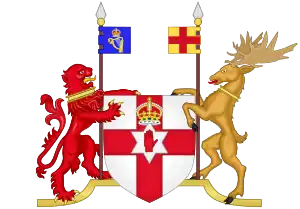.svg.png.webp) | |
| Ulster Banner | |
| Use | |
|---|---|
| Proportion | 3:5 |
| Adopted |
|
| Relinquished | 1973 (Government abolished) |
| Design | Red cross on a white field, decorated by a six-pointed star bearing a red hand and ensigned by a crown. |
| Designed by | Sir Nevile Wilkinson (Ulster King of Arms) |
The Ulster Banner (Irish: Meirge Uladh), also unofficially known as the Ulster Flag or Flag of Northern Ireland, is a heraldic banner taken from the former coat of arms of Northern Ireland, consisting of a red cross on a white field, upon which is a crowned six-pointed star with a red hand in the centre. It was the flag of the former Government of Northern Ireland and common flag of Northern Ireland from 1953 until that government was abolished in 1973 with the passing of the Northern Ireland Constitution Act 1973.
Origin


The arms and flag were designed in Dublin Castle by Major Sir Nevile Wilkinson, Ulster King of Arms, in 1923–1924. The flag is based on the flag of the traditional province of Ulster,[1] including a Red Hand of Ulster in the centre, and the red de Burgh cross[1] (though some claim this is the Saint George's Cross[2]). It has the addition of a crown to represent the monarchy of the United Kingdom. Rather than a shield, the Red Hand is inside a six-pointed star, representing the six counties that make up Northern Ireland. It is blazoned: "Argent a cross gules, overall on a six-pointed star of the field ensigned by an Imperial crown proper a Dexter hand couped at the wrist of the second".
The flag is also sometimes called the Ulster flag,[3] the Northern Ireland flag, the (old) Stormont flag, or the Red Hand of Ulster flag.[4] Loyalists often use "Ulster" as another name for Northern Ireland,[5] and Stormont was the seat of the former Government of Northern Ireland.
History
Use by the Government of Northern Ireland
In 1924, the Government of Northern Ireland was granted its own coat of arms by Royal Warrant and had the right to display these arms on a flag or banner. This right was exercised for the Coronation of Queen Elizabeth II in 1953. From 1953 until 1972 (when the government last sat), the flag was used officially by the Government of Northern Ireland and also as a de facto civic flag for Northern Ireland. In 1973, the Government and Parliament of Northern Ireland were abolished by the Parliament of the United Kingdom under the Northern Ireland Constitution Act 1973.
Later use
Since the Government of Northern Ireland was abolished in 1973, the flag (and variations thereof) has continued to be used by unionists. In 2004, Belfast City Council commissioned a study on the flying of flags that noted that the Ulster Banner continued to be flown, alongside the Union flag, by three unionist-controlled local authorities in Northern Ireland: Ards Borough Council, Carrickfergus Borough Council, and Castlereagh Borough Council.[6]
International sport
The Ulster Banner is used to represent Northern Ireland at the Commonwealth Games,[7][8] to represent golfers on the PGA Tour,[9] and by FIFA to represent the Northern Ireland national football team.[10]
See also
References
- 1 2 "Northern Ireland (United Kingdom)". www.crwflags.com.
- ↑ "CAIN: Symbols - Flags Used in Northern Ireland". cain.ulst.ac.uk.
- ↑ "Page cannot be found". UK Parliament.
- ↑ "Archived copy" (PDF). Archived from the original (PDF) on 30 October 2008. Retrieved 23 October 2008.
{{cite web}}: CS1 maint: archived copy as title (link) - ↑ McGarry, John; O'Leary, Brendan (1995). Explaining Northern Ireland. Wiley. p. 509.
- ↑ "Archived" (PDF). www.belfastcity.gov.uk. Archived from the original (PDF) on 26 March 2009. Retrieved 6 April 2023.
- ↑ "Northern Ireland | Commonwealth Games Federation". thecgf.com. Archived from the original on 20 April 2019.
- ↑ "Telegraph". Archived from the original on 6 April 2008.
- ↑ "Rory McIlroy PGA TOUR Profile - News, Stats, and Videos". PGATour. PGA Tour. Retrieved 6 August 2018.
- ↑ Northern Ireland: Country information, FIFA.com